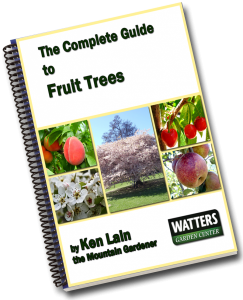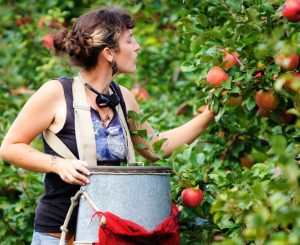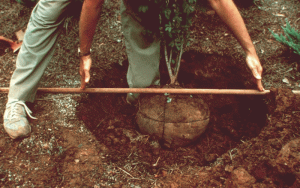 We are excited to announce the publication of our first online ebook: The Complete Guide to Fruit Trees! Inside you’ll find all the information you need to choose the perfect tree on the lot, proper planting techniques, care and pruning, and pollination charts. Plus, get tips from the Mountain Gardener on what products to buy and how to use them.
We are excited to announce the publication of our first online ebook: The Complete Guide to Fruit Trees! Inside you’ll find all the information you need to choose the perfect tree on the lot, proper planting techniques, care and pruning, and pollination charts. Plus, get tips from the Mountain Gardener on what products to buy and how to use them.
Below is an excerpt from the book on how to plant your new fruit tree:
Just as soon as soil can be seen peeking through our snowy landscape it is time to get new fruit trees into the ground. It also is the time to plant grapes and most berry-producing vines. That’s why local garden centers have good selections of these fruit producing plants in late winter/early spring.
Find the Perfect Place
Common sense can direct you in choosing where to plant fruit trees. If your home is built on an elevation, choose the uphill side of the property if possible. Stay away from creeks and drainage areas. The reason is simple: cold air sinks and follows the natural drainage of the land. You are at less risk of frost damage to spring bloom if trees are planted uphill.
Mountain Gardener Tip: It is important to know that a tree grown in mountain clay soil does not send down a typical taproot. Instead it sends out a bent growth that I call a “hockey stick root.” This root will send out runners just under the surface of the soil in order to absorb rain and nutrients from our area’s sporadic rainfall. Because we know this is how the root is going to grow, it only makes sense to give it a hole that is wide but no deeper than the current root ball. My rule of thumb is a hole that is the same depth as the root ball, but three times the width of the roots in the container.
Proper Planting
Remove any rocks and debris that are larger than a golf ball and amend the excavated soil with composted mulch, using one shovel of mulch to three shovels of native earth. At this time, it is good to add a natural fertilizer, too. To save time, blend the soil, mulch, and plant food into a single planting medium.
Mountain Gardener Tip: For the fertilizer, I suggest “Watters All Natural Plant Food 7-4-4;” it is the perfect blend of nutrients to encourage leaf growth which in turn will bring on a hardy root system.
Using your foot, pack down this nutrient rich soil firmly around your newly planted tree so there are no air pockets remaining around the root ball. Water the tree thoroughly with a mixture of water and a rooting hormone that encourages new root hairs to form right away and results in a strong, well-established plant before the stressful effects of summer heat.
The final planting instruction is to stake. Each new tree requires two stakes, one on either side of the root ball.
Mountain Gardener Tip: Use one of my specially designed ‘V-straps’ to secure the tree to the stakes. They allow the tree to move and sway with the wind, but never to snap in two.
 If you want to learn more and get the most fruit from your trees this year and every year after, download our new book for free.
If you want to learn more and get the most fruit from your trees this year and every year after, download our new book for free.
We’d love to hear what you think about our book after reading it, so feel free to leave a comment below!


